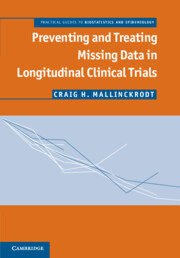Book contents
3 - Estimands
Published online by Cambridge University Press: 05 February 2013
Summary
Introduction
An important evolution in the discussions on missing data has been the focus on clarity of objectives. In fact, the first recommendation from the recent National Research Council (NRC, 2010) recommendations on the prevention and treatment of missing data was that the objectives be clearly specified.
The need for clarity in objectives is driven by ambiguities arising from the missing data. As noted in Chapter 2, data may be intermittently missing or missing due to dropout. Patients may or may not be given rescue medications. Assessments after withdrawal from the initially randomized study medication or after the addition of rescue medications may or may not be taken. Whether or not – and if so, how – these follow-up data should be used in analyses and inference is critically important.
Conceptually, an estimand is simply what is being estimated. Components of estimands for longitudinal trials may include the parameter (e.g., difference between treatments in mean change), time point or duration of exposure (e.g., at Week 8), outcome measure (e.g., diastolic blood pressure), population (e.g., in patients diagnosed with hypertension), and inclusion/exclusion of follow-up data after discontinuation of the originally assigned study medication and/or initiation of rescue medication.
- Type
- Chapter
- Information
- Preventing and Treating Missing Data in Longitudinal Clinical TrialsA Practical Guide, pp. 15 - 20Publisher: Cambridge University PressPrint publication year: 2013



